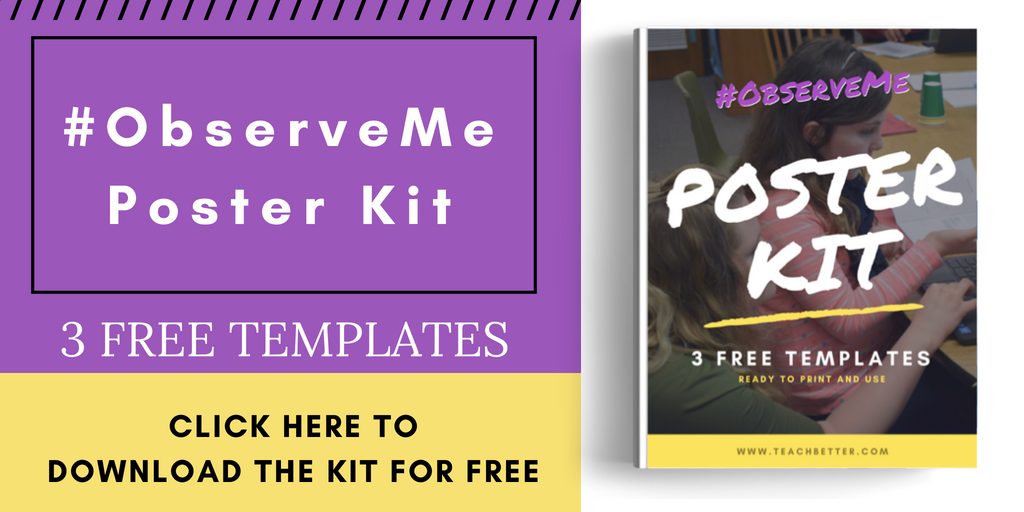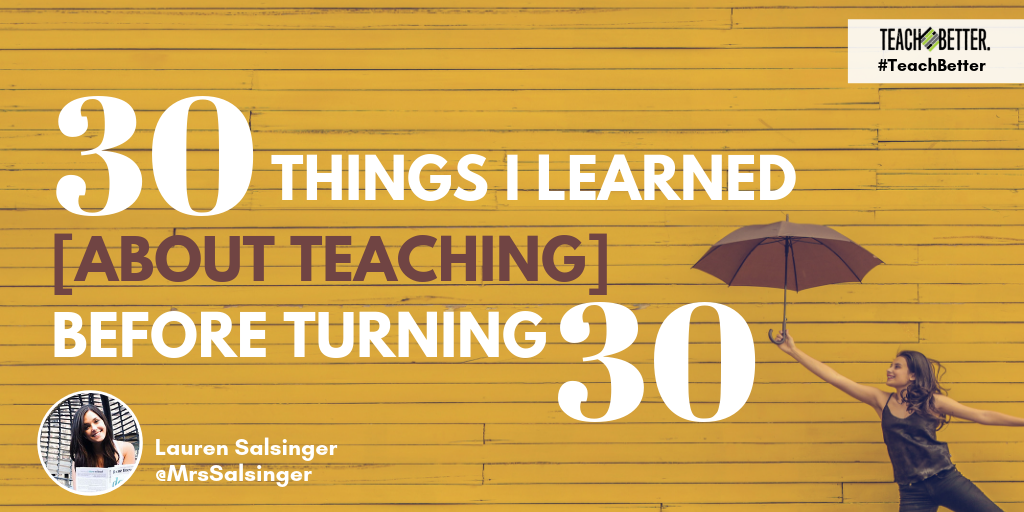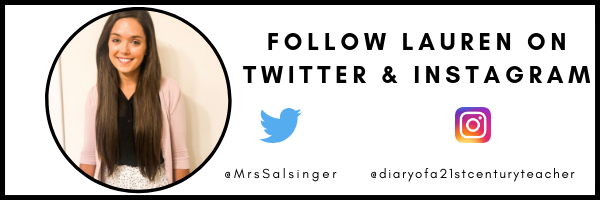If Taylor Swift did it, why can’t I? Turning 30 is weird for me, mainly because everyone says it’s great, but I loved my 20s SO much that it’s hard to imagine better! It’s the time I got my dream job…and in that same decade have been referred to as a veteran teacher. I’ve worked with many students in so many different ways. I have failed often and through constant reflection, I have learned every time.
Here are 30 things I learned about teaching before I turned 30.

ONE
I learned to embrace change. Change is hard. It takes time and energy and it is vulnerable. Change, however, is inevitable. To look at change as a good challenge instead of a threat is in the best interest for students and will help maintain positivity. Change pushes you outside of your comfort zone, and allows you to grow.
TWO
I learned my time is precious…and so is others’. Too easily time can get away from us — when it comes to a mini-lesson, a planning period, or even just the weekend. I learned quickly that time is always something I’m seeking more of. In working with other teachers, though, I also saw how important others’ time is. It made a difference when I sent a student 5 minutes late to speech. It mattered that one time the one student skipped their violin practice. It’s so important to respect not only my time, but others’ as well.
All teachers are doing what they think and have learned is best for students. Click To TweetTHREE
Relationships are everything. If you listen to my interview on the Teach Better Talk podcast, I shared a story about a huge failure I had. With stressors of never-ending to do lists and a group of students that challenged me, I missed out on an opportunity to connect with a student at a time when they needed it. From that point forward, I promised myself that relationships always always always come first.
FOUR
I learned that it’s totally fine if I don’t know the answer to something that students ask. I used to think that in order to be respected by my students, I should know all the answers, and should be an expert in all content areas. Then I learned that in the right kind of classroom environment, students are constantly asking questions, seeking to learn as much as they can. By cultivating that culture of curiosity, it is impossible to know all the answers. When students are given the chance to find answers on their own, it empowers them.
FIVE
I learned my role isn’t harder or more important than others’. One of the cool things about going from a classroom teacher to a coaching role is getting the opportunity to see and understand a wide range of perspectives. In the classroom, I was so guilty of telling myself stories of how, “It’s harder for me because I have less plan time than certain teachers,” or, “There’s less pressure on certain teachers.” In working with all different teachers and seeing a school in a more holistic way, it’s clear to me that E.V.E.R.Y.O.N.E. is riding the struggle bus at times, and that if you perceive someone’s job as “easy,” (or at least easier than yours) then you either (a) Don’t know enough about it or (b) are frustrated with something else and are taking it out on someone rather than addressing your own issues.
[scroll down to keep reading]
SIX
Getting involved outside of school makes everything better. Getting to know your students, families, and colleagues on a more personal level allows everyone to show more empathy, and it’s just FUN. Attend sporting events that you get invited to, go to the dance recital if you have time, attend the work party. Last year I took my class and their families to see Wonder, and it was such a great bonding experience for all of us. This year I joined the 7th graders to our overnight outdoor ed, and 8th graders all the way to DC! I got to know more students and teachers on a different level, and it makes coming to work each day so much more enjoyable.
SEVEN
Taking on leadership roles is tough, but worth it. I remember teaching my first year, seeing another teacher run the RtI meetings, and I thought, “I will NEVER do that job.” I was scared that I didn’t know enough about the process and that it would take up too much time. Fast forward 2 short years, and I had an administrator ask me if I’d be willing to try it out. Surprised she had faith in me to take on such an important role, I said yes…and I learned SO. MUCH. Not only that, but I got to work with teachers on a different level and impact students in a completely different way.
EIGHT
ALL kids are good…even that one. Time and time again, it shows that the kids who need the most help ask for it in the hardest ways. This goes for “that one” student, or even when your class seems to be doing “everything wrong.” Were expectations clear? Is there something else going on making this student act this way? Most students want to do the right thing, and if you approach situations giving students the benefit of the doubt, it’s easier on everyone.
NINE
Students are motivated by choice. There are so many ways to give choice to students. Let them choose what they learn, how they learn, how they show what they learn, or even where they learn! The first time I really implemented Personalized Learning was my third year teaching. I saw what empowered students look like. Because they were given freedom and trust, they were motivated to deliver. They not only exceeded my expectations in their day to day activity during this project, but in their mindset as well.
TEN
I learned that students have awesome ideas. Over the course of my teaching, I have become more and more student-centered in my instruction. I ask their opinions, let them come up with things, and even give them a chance to write the rubric! The more I put on the students, the more initiative they take in their learning.
ELEVEN
Connecting with other educators will make you a better teacher. Just about every great activity that I’ve done involved some sort of collaboration with other teachers. Isolating yourself closes you off to different ideas and perspectives.
TWELVE
EVERY student is so very different. Don’t make assumptions, group, or categorize students. Get to know them and what makes them unique, no two are the same!
THIRTEEN
Judging other teachers is lame. There isn’t a right or wrong way to teach. I know something I used to get judgmental over was when teachers were really outdated in their practices. Then I thought about them like I think about my students. All teachers are doing what they think and have learned is best for students. Of course there are exceptions, but I’d like to believe in the greater good.
FOURTEEN
8th graders aren’t scary. Ok, so I never thought 8th graders were SCARY, but working with students that old was definitely out of my comfort zone. It took one lesson to realize that my fourth grade teacher sense of humor totally translate to a middle school. I decided to take the plunge and really get to know them and build relationships, and now I really LOVE working with 8th graders!
FIFTEEN
There is only one kind of tape that works on walls. Nitto Double Coated Kraft Paper Tape. It’s crazy expensive for tape, but the roll lasts the whole year, and the thing stays on the wall forever. This is not an ad, I’m just obsessed with this tape.
SIXTEEN
If I HATE grading it, it’s not a good assessment. Grading is my least favorite part of teaching as it is, but there are certain assignments that I despise. Specifically the ones that take a really long time to grade, and it’s the same response over and over again, and I know the feedback will be overlooked. We should use assessment AS learning. Students need to be a major part of the assessment process, and it needs to be a true reflection of what they know and where they can go.
SEVENTEEN
It is ok to say no. I hate conflict and tend to be a people pleaser at times. I’m also someone who geeks out when it comes to anything education, so I find myself saying yes to everything. Although I love being busy and having a voice, it took a toll on my mood and I found myself constantly just trying to stay afloat. When I get asked to do something now, I think about if it’s something that I value or if it would be beneficial to the greater good. THEN I ask myself…Do I have time to invest in this? If the answers are yes, I dive in headfirst. If the answers are no, I pass.
EIGHTEEN
Instagram is cool, but it doesn’t determine whether or not you’re a good teacher. The comparison struggle is REAL. Sometimes scrolling through these beautiful classrooms or cute activities makes me feel like a slacker…which couldn’t be more untrue. You do you! Instagram is JUST a highlight reel!
NINETEEN
I can’t please everyone… But you bet I tried! I’m super hard on myself. I put a lot of thought and consideration into all that I do, and tend be be a people pleaser. This means that when parents, colleagues, or anyone for that matter says anything negative about my choices, it’s really hard for me to hear. A way I’ve coped with this is through reflection. I reflect on WHY I made decisions (see 20).
TWENTY
If I made my decision keeping in mind the best interest of students, it was the right decision. Don’t do it for the Gram. Don’t do it to cut corners and save time. Don’t do it to “look good.” Don’t do it because your colleagues did it. Don’t do it because that’s what the teacher’s manual says so. Make decisions for the STUDENTS.
TWENTY ONE
I learned that my students don’t need a friend, they need a loving teacher. Too often teachers try to befriend their students in order to build relationships. There’s a difference between being a friend and being their teacher. Often times when teachers “friend zone” their students, classroom management becomes a struggle. Students are looking for mutual respect, kindness, and realness. You don’t need to be their friend to provide them that.
TWENTY TWO
I learned that students feed off of my energy. Negative? Frustrated? Flustered? Excited? TOO silly? I’ve imposed my energy on my students plenty of times, and it will probably happen again since I’m a human with real emotions. I’m aware of my effect on students, and I work to stay positive. I don’t put down programs or activities, and I do my best to keep any negativity at the door.
TWENTY THREE
Kids remember that one time you did a cartwheel to be funny, but not the one lesson you prepared for hours. Working in a school with over 60 of my old students, I’ll often chat with them about their fourth grade memories. Very few have recalled a specific activity we did, but ALL remembered the funny things that happened in class.
TWENTY FOUR
Email is not always the best way to communicate. It has a time and a place for sure, especially if it’s just an informative message for a large group of people. Discussing student behaviors or addressing any sort of conflict is simply not effective. Tones can be misread, and often times people say things in email that they’d never say to your face. Having a phone or face to face conversation can avoid a lot of miscommunication.
TWENTY FIVE
We’re all in this together. Teaching isn’t a competition! Ask for help and advice and collaborate with other educators! There is power in numbers and unity!
TWENTY SIX
Negativity is contagious. Surround yourself with positive people. It’s too easy to get caught up in complaining, and it’s just not helpful or productive.
TWENTY SEVEN
Technology is just a tool. My first year teaching I remember thinking that good teachers use technology. I used technology constantly, and in ways that truly just substituted what they could be doing on paper. Technology allows for creation of previously inconceivable tasks, and it makes certain tasks significantly more convenient. That’s how I use technology now.
TWENTY EIGHT
School isn’t the only important thing. Everyone has lives outside of the classroom, and it shapes who they are and what they bring to school each day. This realization helped me grow relationships and has really changed my views on things like homework.
TWENTY NINE
I’ve learned to make checklists. This probably feels like how to be teacher 101 to many. I’ve always been someone who has a to-do list going in my head, but I quickly learned that there is just too much to remember. I then progressed to having 15 checklists in different places, which is also ineffective. Google Keep has been my life saver. Keeping specific checklists keeps me productive, efficient, and sane.
THIRTY
Readers are leaders. I found how important it is to make time for professional reading. Whether it’s reading books your students are reading, teacher books, blogs, or Tweets, having that knowledge is so powerful! Start book clubs at your building, or talk about the books you’ve read with students or when connecting with other educators online.
About Lauren Salsinger
I am currently a Student Learning Coach at a middle school. This means that I get to work with all teachers to help empower students and increase their voice and choice in the classroom. I graduated from Illinois State University with a degree in Elementary Education. I taught in an elementary school for seven years, primarily in a fourth grade classroom. During this time I also earned a Masters in Reading through Concordia University. I believe that getting involved with your school and community is so important as an educator. I took on a leadership role of RtI Facilitator, led numerous student clubs, and taught PD courses for teachers. This led to my interest in educational leadership. I am currently working toward a Master’s in School Leadership. My role as Student Learning Coach affords me many leadership opportunities, and every day is a different journey!



